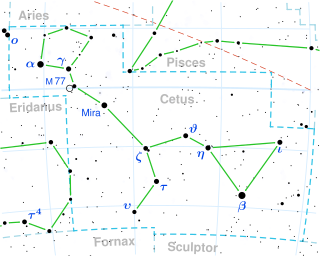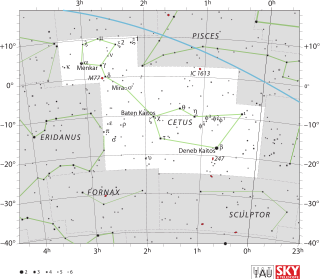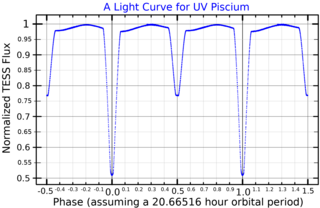79 Ceti, also known as HD 16141, is a binary star system located 123 light-years from the Sun in the southern constellation of Cetus. It has an apparent visual magnitude of +6.83, which puts it below the normal limit for visibility with the average naked eye. The star is drifting closer to the Earth with a heliocentric radial velocity of −51 km/s.

Epsilon Ursae Minoris is a binary star system in the northern circumpolar constellation of Ursa Minor. It is visible to the naked eye with a combined apparent visual magnitude of 4.19. Based upon an annual parallax shift of 10.73 mas as seen from the Earth, it is located around 300 light years from the Sun. The pair are drawing nearer to the Sun with a radial velocity of −10.57 km/s.

12 Camelopardalis is a binary star in the northern circumpolar constellation of Camelopardalis, located 700 light years away from the Sun as determined from parallax measurements. It forms a double star with 11 Camelopardalis, which is only 3 arcminutes away. The system has the variable star designation BM Camelopardalis; 12 Camelopardalis is the Flamsteed designation. It is just visible to the naked eye, appearing as a dim, orange-hued star with an apparent visual magnitude of 6.08. The system is moving closer to the Earth with a heliocentric radial velocity of −2 km/s.

42 Capricorni is a binary star system in the zodiac constellation of Capricornus. It has a combined apparent visual magnitude of 5.18, so it is faintly visible to the naked eye. Its annual parallax shift of 30.09 mas yields a distance estimate of about 108 light years; the system is moving closer to the Sun with a radial velocity of −1.2 km/s. 42 Capricorni is 0.2 degree south of the ecliptic and so is subject to lunar occultations.

HR 5553 is a binary star system located thirty-eight light-years away from the Sun, in the northern constellation Boötes. It has the variable star designation DE Boötis, and is classified as an RS Canum Venaticorum variable that ranges in apparent visual magnitude from 5.97 down to 6.04, which is bright enough to be dimly visible to the naked eye. The system is drifting closer to the Sun with a radial velocity of −30 km/s, and is expected to come as close as 26.9 light-years in 210,000 years.

EQ Virginis is a single variable star in the equatorial constellation of Virgo. It has a baseline visual apparent magnitude of 9.36, but is a flare star that undergoes sporadic bursts of brightening. The star is located at a distance of 67 light-years from the Sun based on parallax measurements, but is drifting closer with a radial velocity of −23 km/s. It is a member of the IC 2391 moving group of stars, which is between 30 and 50 million years old.

Omicron Draconis is a giant star in the constellation Draco located 322.93 light years from the Earth. Its path in the night sky is circumpolar for latitudes greater than 31o north, meaning the star never rises or sets when viewed in the night sky.
AM Canum Venaticorum is a hydrogen-deficient cataclysmic variable binary star in the constellation of Canes Venatici. It is the type star of its class of variables, the AM Canum Venaticorum stars. The system consists of a white dwarf gaining matter via an accretion disk from a semi-degenerate or white dwarf companion.

ν Ceti, Latinized as Nu Ceti, is a binary star system in the equatorial constellation of Cetus. It is visible to the naked eye as a faint point of light with a combined apparent visual magnitude of 4.86. The system is located approximately 340 light years distant from the Sun, based on parallax, and is drifting further away with a radial velocity of 4.8 km/s. Nu Ceti is believed to be part of the Ursa Major stream of co-moving stars.

Xi1 Ceti , Latinized from ξ1 Ceti, is a binary star system located in the equatorial constellation of Cetus. It is visible to the naked eye with a combined apparent visual magnitude of +4.36. The distance to this system is approximately 340 light years based on parallax measurements, and it is drifting closer to the Sun with a radial velocity of −4 km/s. The proximity of the star to the ecliptic means it is subject to lunar occultations.
Tau1 Eridani, Latinized from τ1 Eridani, is a binary star system in the constellation Eridanus. It has an apparent magnitude of 4.46, making it visible to the naked eye in suitably dark conditions. This is a spectroscopic binary with an orbital period of 958 days. It is located about 46 light years from the Earth. At present, the system is moving away from the Sun with a radial velocity of +26 km/s. About 305,000 years ago, perihelion passage was made at an estimated distance of 30.5 ly (9.35 pc).

50 Persei is a star in the constellation Perseus. Its apparent magnitude is 5.52, which is bright enough to be seen with the naked eye. Located around 21.00 parsecs (68.5 ly) distant, it is a White main-sequence star of spectral type F7V, a star that is currently fusing its core hydrogen. In 1998 the star was named a candidate Gamma Doradus variable with a period of 3.05 days, which would means it displays variations in luminosity due to non-radial pulsations in the photosphere. Subsequently, it was classified as a RS Canum Venaticorum and BY Draconis variable by an automated program.

Sigma Coronae Borealis is a star system in the constellation of Corona Borealis. It is a quintuple star system containing three sunlike main-sequence stars and two other low-mass stars. The combined visual magnitude is 5.3 and the system lies 74 light years from Earth. σ CrB A is the variable star TZ Coronae Borealis.
c Ursae Majoris is the Bayer designation for a double-lined spectroscopic binary star system in the northern constellation of Ursa Major. It has an apparent visual magnitude of 5.18, which indicates that is visible to the naked eye. Parallax measurements yield an estimated distance of 66 light years from the Sun. The star is moving closer to the Earth with a heliocentric radial velocity of −14 km/s.

RS Canum Venaticorum is a binary star system in the northern constellation of Canes Venatici. It serves as the prototype to the class of RS Canum Venaticorum variables. The peak apparent visual magnitude of this system is below the level needed to observe it with the naked eye. It is located at a distance of approximately 443 light years from the Sun based on parallax, but is drifting closer with a net radial velocity of −14 km/s. Olin J. Eggen (1991) included this system as a member of the IC 2391 supercluster, but it was later excluded.

SZ Piscium is a triple star system in the equatorial constellation of Pisces. The inner pair form a double-lined spectroscopic binary with an orbital period of 3.966 days. It is a detached Algol-type eclipsing binary of the RS Canum Venaticorum class with a subgiant component. The system is too faint to be readily visible to the naked eye with a combined apparent visual magnitude of 7.18. It is located at a distance of approximately 306 light years based on parallax measurements.

UV Piscium is a binary star system in the constellation of Pisces. With a peak apparent visual magnitude of 8.98, it is too faint to be visible to the naked eye. This is an eclipsing binary system that decreases to magnitude 10.05 during the primary eclipse, then to magnitude 9.54 with the secondary eclipse. It is located at a distance of 232 light years from the Sun based on parallax measurements, and is receding with a radial velocity of 6.5 km/s. The position of this star near the ecliptic means it is subject to lunar occultation.

ER Vulpeculae is a binary star system in the northern constellation of Vulpecula, abbreviated ER Vul. It is a variable star system with a brightness that ranges from an apparent visual magnitude of 7.27 down to 7.49, which is too faint to be visible to the naked eye. This system is located at a distance of 165 light years from the Sun based on parallax measurements. It is drifting closer with a radial velocity of −25 km/s.

DM Ursae Majoris is a binary star system in the northern circumpolar constellation of Ursa Major, abbreviated DM UMa. It is sometimes identified by the Bonner Durchmusterung catalogue designation BD +61 1211; DM UMa is the variable star designation. The system has a combined apparent visual magnitude of 9.29, which is too faint to be visible to the naked eye. Based on parallax measurements, the system is located at a distance of approximately 606 light years from the Sun, but it is drifting closer with a heliocentric radial velocity of −7 km/s.

AR Piscium is a binary star system in the northern constellation of Canes Venatici, abbreviated AR Psc. It has the Henry Draper Catalogue identifier HD 8357; AR Piscium is its variable star designation. The pair have a combined apparent visual magnitude that fluctuates around 7.24, which is too faint to be readily visible to the naked eye. Parallax measurements place it at a distance of 148 light years from the Sun. The motion of this star through the Milky Way suggests it is a member of the intermediate disc population.
















